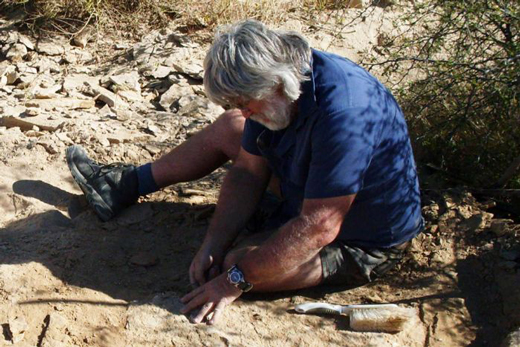Rare Prehistoric Seagull from the Outback
Nanantius eos and the Eromanga Sea
A new species of prehistoric bird from the Cretaceous has been described – Nanantius eos.
The Queensland town of Richmond may be several hundred miles from the Coral Sea that laps against the coast of north-eastern Australia, but back in the Cretaceous this part of world, famous for its droughts and arid outback, was covered for millions of years by a shallow, tropical sea (the Eromanga Sea), that teemed with prehistoric life. Thanks to the efforts of volunteers and the dedicated researchers at Richmond’s Kronosaurus Korner a new ancient resident has been identified, not a sea monster, or an ancient fish but a primitive bird that probably filled an ecological niche similar to today’s seagulls.
Nanantius eos
Swooping into view comes Nanantius eos, the name translates as dawn dwarf-enantiornithine*. Slighter smaller than a Common Tern (Sterna hirundo), perhaps weighing no more than a couple of hundred grammes, the fossils come from marine sandstone deposits that were laid down more than 100 million years ago, (Aptian to Albian faunal stage of the Cretaceous).
Fossils of Nanantius have been found in Winton sandstone exposures around three-hundred miles to the south-west of Richmond, but these consist of only a few isolated bones. Working at a site just eight miles from the centre of Richmond, Dr Patrick Smith (Curator at the Kronosaurus Korner Fossil Museum), is confident that the number of bird bones found so far indicates that there might be complete skeletons present in the deposit.
Pictures of the Fossil Material Ascribed to Nanantius eos from the Richmond Site
Picture credit: Dr Patrick Smith
Dr Smith commented:
“It’s very, very rare to find dinosaurs out here, there’s only been about a handful known, so finding these dinosaur birds is amazing. We haven’t had any of these sorts of primitive birds found in Richmond.”
The “Richmond Raptor”
Volunteer Mike D’Arcy found the first evidence of a fossil bird some five years ago. Ever since his first discovery, he has been busy recruiting volunteers to help him find more fossil evidence. As, for much of the Early Cretaceous, Richmond was underwater and many miles from land, it is surprising to find evidence of an enantiornithine bird in marine sandstone deposits.
Scientists are unsure how the bird fossils came to be deposited. Do they represent an accumulation of carcases of birds washed out to sea? Or perhaps flocks of Nanantius eos (which was probably a capable flyer), may have flown out far to sea in order to feed. Mike has nick-named the bird the “Richmond Raptor”. It did have small, sharp teeth in its jaws and claws on its wings but small fish and insects were probably its choice of prey.
Volunteer Mike D’Arcy Working at the Fossil Site
Picture credit: Mike D’Arcy
A spokesperson from Everything Dinosaur commented:
“Local residents can play an important role in helping palaeontologists to collect fossils from sites, that the palaeontologists themselves may not have time to visit and explore themselves. Thanks to these volunteers, many fossils that would otherwise have been eroded away can be saved, permitting scientists the opportunity to study them.”
Likely Member of the Enantiornithine Clade*
Although described as a member of the Enantiornithes clade, a group of abundant, primitive birds of the Cretaceous, it is hoped that the Richmond fossils will be able to confirm this assessment. Previously, fossils found near the small town of Boulia, (Queensland), included a partial tibiotarsus (ankle and lower leg bone), were attributed to Nanantius. The shape of this bone was once thought to be diagnostic of the enantiornithines but more recent Mesozoic bird discoveries have cast doubt on the morphology of the tibiotarsus being suitably diagnostic of a enantiornithine affinity. With more fossil bones found, including limb elements (humerus and unguals), palaeontologists may be able to confirm the taxonomic position of N. eos.
Examining a Pedal Ungual (Nanantius eos)
Picture credit: Mike D’Arcy
The Search for More Evidence of Nanantius eos
Mike D’Arcy added:
“The first half a dozen pieces I got, we couldn’t really assign what it was and it wasn’t until we got the humerus that we could say it was definitely a bird.”
The fossils are currently on display at the Kronosaurus Korner Fossil Museum. Nanantius is regarded as seabird as fossils have been found in association with marine deposits.
In addition, in 2003, a paper was published in the “Proceedings of the Royal Society – Biology” that described the stomach contents discovered in association with a gravid female ichthyosaur (Platypterygius longmani). Amongst the fossilised remains of baby turtles and fish, the scientists discovered limb bones from an enantiornithine bird, probably from the Nanantius genus. How the bones came to be in the body cavity of an ichthyosaur is unknown, perhaps the marine reptile grabbed the bird as it rested on the water, or maybe the ichthyosaur had fed on a corpse that had been washed out to sea.
Visit the website of Everything Dinosaur: Everything Dinosaur.




